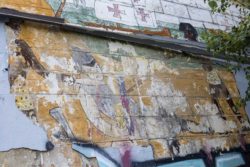Spring 2018
Ghosts of Desire
Revolutionary art is rediscovered in a trash heap 45 years after its creation
Published: March 8, 2018
Last Updated: April 23, 2019

Photo by Mark Sindler, Louisiana State Museum.
The mural covers the wall of an abandoned shopping mall.
Amid the debris, Greg Lambousy, Director of the New Orleans Jazz Museum, spotted a long iron rod with a curve like a shepherd’s crook and used it to pull down a gutter. We were trying to get a better look at what we’ve come to call “the Panther mural.”
Though few today may remember this, a New Orleans chapter of the Black Panthers was established in 1970, when they took up residence in a Desire Public Housing Development unit and vowed to stay there to protect residents from police. Champions of the poor, unifiers, revolutionary educators, the Panthers were dreaded by some—including FBI director J. Edgar Hoover, who vowed to eradicate them—and a source of inspiration to others.
Painted on cinder block, covered over with stucco years ago, and relegated to oblivion, this mural appears to date back to the Panther tenure, depicting themes of African-American empowerment and militancy from the era of black nationalism.
The most recent chapter in the Panther mural saga began last spring, when Joe Fraiman, chief medical resident at the Louisiana State University Medical Center, was driving home from a search-and-rescue training session. A detour took him by the abandoned, grafitti-splashed mall. “It had a presence to it. I had my rescue boots on, and I enjoy these kind of impressive spaces,” Joe told me, so he stopped to take a look. On closer inspection, what caught his eye was a well-preserved artwork slowly revealing itself as the stucco fell away from one exterior wall. “There’s something very special here,” he texted fellow medical resident Jenn Hissett, who is also an archaeologist.
Soon a small group of us were speculating about what this artwork could be or mean. I wrote an article about it in The Lens, and within weeks, Ricardo Coleman, an instructor at Delgado Community College and the University of New Orleans, contacted me. He said that he had not seen the mural since he was a child; he had assumed that it, along with Bynum’s Pharmacy, housed in the building on which it was painted, were both long gone.
“I can certainly remember that it contained violent and powerful images that stirred up many emotions when I first saw it,” Coleman said. “Initially, I was afraid of it. I just didn’t understand what it all meant. I can tell you that it definitely seemed to tell a story. But it also caused me to ask questions, and I think maybe that was the beginning of my love affair with history.”
“One of my teachers told me that it was erected shortly after the Black Panthers’ confrontation with the New Orleans Police Department,” he said. “It was intended to educate young people just like me about the history of black people in America. I can also remember that while everything in the neighborhood was ‘fair game’ for graffiti, no one ever tagged the mural.”
A few months later, I was at a Panther reunion panel organized by Malik Rahim, a Panther who went on to perform a heroic role in the Hurricane Katrina recovery effort as founder and head of the community group Common Ground. I spoke with a man named Wesley Philips, who said he had lived in Desire from 1956 until 1981 and that he remembered the mural well. He confirmed Coleman’s hunch that the artist was Bruce Brice, a distinguished New Orleans painter among whose accomplishments was the design of the very first Jazz Fest poster, in 1970.
Brice died two years ago, at the age of seventy-two. But his website is still up and running, so I gave it a look. There, right at the top, stood a decades-old photograph of the mural as it looked when newly painted. “My goal,” Brice had written on the site, “is to teach . . . to enlighten others about the rich African-American experiences, culture, and traditions in this region. Through various mediums, I am able to link the past to the present and form positive visions of the future.”
Just as I was mulling over how in the world this historical treasure could be documented, appreciated and preserved, Tulane professor and historian Lawrence Powell happened to call me to discuss another matter. As chairman of the board of the Louisiana State Museum, he agreed to begin the preservation process on the mural.
Powell’s perfectly timed phone call is only the latest in a series of improbable occurrences. No doubt there will be others as this piece circulates and the ghosts of our revolutionary past crawl out of cracked stucco and rubbish and years of neglect, clamoring to be seen and heard.
————————
Orissa Arend is a mediator, psychotherapist, and author of Showdown in Desire: The Black Panthers Take a Stand in New Orleans. You can reach her at [email protected].
